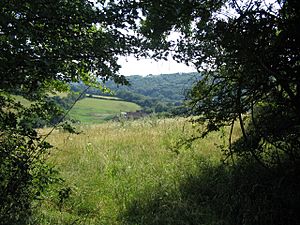Honeybrook Farm facts for kids
Honeybrook Farm is a working farm located in Wiltshire, England. It's about 3 miles (5 km) south of Castle Combe, between the villages of Biddestone and Slaughterford. The farm covers a total area of 65 hectares (160 acres). A large part of it, 42.41 hectares (104.8 acres), is a special protected area. This area is known as a Site of Special Scientific Interest, meaning it's important for its unique plants and natural features.
The Farm's Special Land
Honeybrook Farm is found within the beautiful Cotswold Area of Outstanding Natural Beauty. A small stream called the By Brook flows through part of the farm. The special protected area on the farm is very important. It has meadows full of different herbs and high-quality grassland. These areas are special because of the types of plants that grow there.
The farmers at Honeybrook have a small group of Hereford cattle. They also have some sheep and grow a small amount of barley in the spring. What makes Honeybrook Farm unique is how it's managed. It's one of the few farms in Britain that has always used gentle farming methods. This means they have never used strong agricultural chemicals on the land.
The ground under the farm is made of a type of rock called oolitic limestone. This is common in the Wiltshire Cotswolds. The farm has two main parts. There's a dry valley to the east. To the west, there's part of the flat land next to the By Brook stream.
Amazing Plants at Honeybrook
The hay meadows at Honeybrook Farm are full of many different grasses and herbs. These plants show that the land has been farmed gently for a very long time. Because no chemicals have been used, the meadows have a wide variety of typical meadow plants.
You can find plants like black knapweed (Centaurea nigra) and yellow rattle (Rhinanthus minor). Another common plant is bird's-foot-trefoil (Lotus corniculatus). The soil in the hay meadows has a lot of lime. This allows special plants to grow, such as salad burnet (Sanguisorbor minor), upright brome (Bromus erectus), and hoary plantain (Plantago media).
In wetter areas along the field edges, you might see plants that like damp conditions. One example is common meadow-rue (Thalictrum flavum). This plant is quite rare in North Wiltshire. The ditches around the meadows also have many wetland plants. The areas where the meadows meet old woodlands are also home to a rich variety of plants. This mix of plants is now rare in lowland Britain.
Ancient Discoveries
People have found old objects from Roman times near Honeybrook Farm. These discoveries show that people lived and worked in this area many centuries ago.


